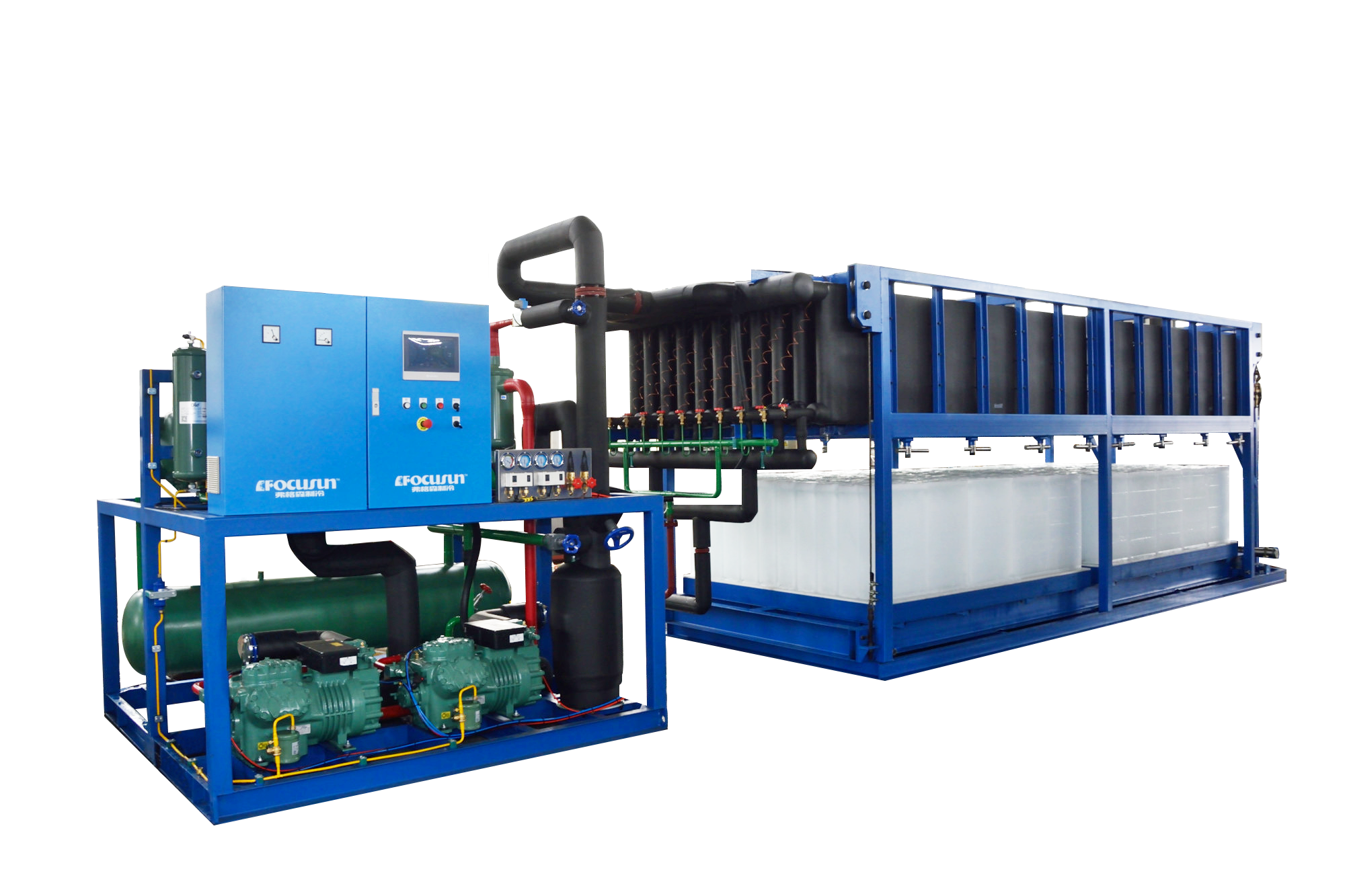6
2014
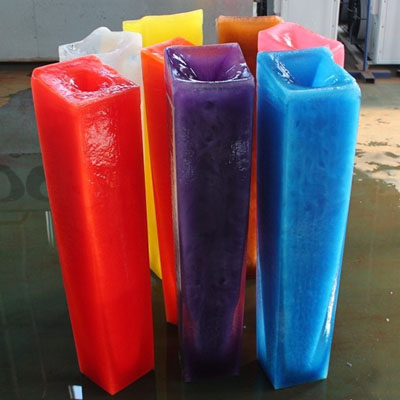
Block Ice Plants
Introducing The Process and Principles of Block Ice Manufacturing – history, innovation, technology and more.
An ice machine, ice generator, ice plant, ice maker; call it what you want to, refers to the device for making ice, mostly found in your home freezer of your refrigeration gadget, a stand-alone appliance for producing ice or an industrial machine purposely built for large scale ice manufacturing.
Commonly, we refer to the whole gadget as the “ice generator”. However, the ice generator is one of the main parts of the whole machine and its function is to generate ice.
There are different types of artificial ice making machines, each designed for its use and purpose; e.g. the Block Ice Plant, Tube Ice Machine, Flake Ice Maker, Cube Ice Machine, Plate Ice Plant etc.
History
According to Schmidt L.M., the art of artificially freezing water to make ice cannot be acclaimed as a modern science. He explains, ages ago, in India, water was frozen in thin permeable earthen dishes resting on some non-conducting material such as straw or grass by being exposed to currents of air during the night.
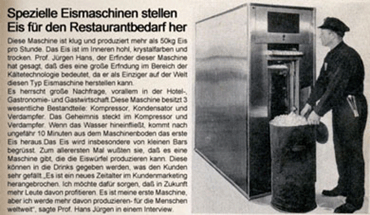
- In 1748, the first known artificial refrigeration was demonstrated by William Cullen at the University of Glasgow.
- In 1844, an American physician, John Gorrie, built a refrigerator based on Oliver Evans’ design to make ice to cool the air for his yellow fever patients.
- In 1929, Dr. Jurgen Hans from Germany created the first tube ice plant capable of manufacturing edible ice tubes. In 1932, he founded his business venture Külinda in Frankfurt, which produced tube ice for restaurant demands. Külinda is now world renowned with business ventures as far as China; Focusun Refrigeration Corporation.
Principle of ice making
All refrigeration system use the same principles of generating ice; however, the method may differ putting into account some others factors. Nevertheless, Schmidt L.M. classify the refrigeration method in two main classes; Direct and Indirect Refrigeration.
Refrigeration
Refrigeration is the process of removing heat from an enclosed space, or from a substance, and moving it to a place where it is unobjectionable. The main principle of refrigeration is lowering the temperature of the enclosed space or substance and then maintaining that lower temperature. Cold conditions can be created by removing heat, for this reason, in order to reduce a temperature, one “removes heat”, rather than “adding cold.
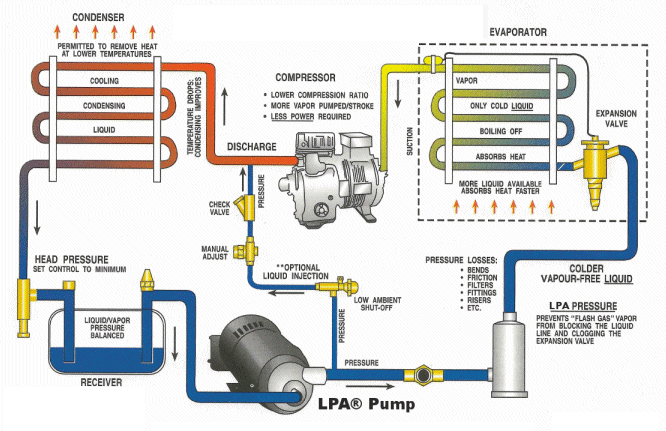
Direct Refrigeration System
In this method of refrigeration, an evaporator is placed directly in the chambers or rooms desired to be cooled. When the refrigerant is allowed to expand in the coils of the evaporator, the surrounding pipes are cooled and absorb heat from the surrounding chamber or room, affecting the cooling as desired.
Brine or Indirect Refrigeration System
This system incorporates an intermediate liquid to transport chilled liquid between the refrigeration equipment and the process. It is employed where the space or product to be cooled is separated from the condensing equipment. Water, brine or some other suitable liquid is cooled by a direct-expansion refrigerant and pumped to the spaces or products being refrigerated. In these applications, the cooled liquid is called a secondary refrigerant. Secondary refrigerants are circulated directly to the product or vessel to be refrigerated or indirectly to several locations using air-cooling heat transfer coils.
The advantage of indirect refrigeration is that, the cooling process is kept separate from the product or vessel being cooled. This is method is useful where the leakage of refrigerant and oil from the piping would cause undesirable contamination or product harm.
| Weight (Kg/Block) |
Dimension (L*B*H / mm) |
|---|---|
| 5 | 120 × 100 × 460 |
| 10 | 155 × 100 × 700 |
| 15 | 185 × 125 × 700 |
| 20 | 245 × 125 × 700 |
| 25 | 315 × 125 × 700 |
| 50 | 480 × 160 × 700 |
Block Ice Making Process
The block ice making process in Block Ice Plants is the same in principle as the above mentioned ice making plants. Some industrial block ice machines use the Brine (indirect) system of ice making while others use the direct system. Each system depends on the purpose and use of each machine. The thickness of ice blocks produced also depends on the use of the ice; the most common weight produced for industrial purposes ranges from 5kg to 50kg.
Brine or Indirect Refrigeration Technology System
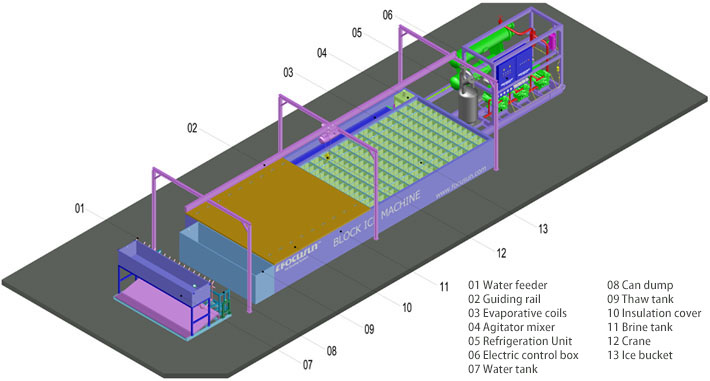
Machines adopting this system may use salt water as heat transfer medium. Temperature goes down as far as -5 degrees Celsius through its heat exchange with refrigerant. Cold brine water then continues to cool the ice cans where the ice is then formed. The use of this machine and system of ice making is mostly popular along coastal and tropical areas.
Direct Refrigeration Technology System
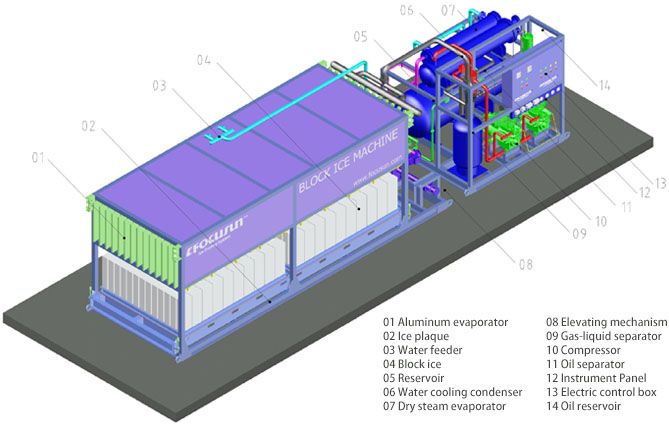
Block ice makers that use this system produce ice blocks after direct heat exchange between the refrigerant and water; depending on the thickness of ice being produced, water can be frozen into ice between 4-8 hours. After the ice is formed, a Program Logic Control (PLC) controls the machine automatically into ice doffing process. Most commonly, this system utilizes hot Freon to defrost the ice which make the defrosting process much faster. For durability and also to conform to food hygiene standards, the plates of the evaporator are constructed using special aluminum alloy, from which the Freon gas can follow constantly. Water outside can be frozen quickly and directly, without any power or energy waste. It is the reason why this refrigeration technology is more advanced and efficient than the brine tank system.
| Note: Both system can produce quality, hygienic and consumable crystal or milky ice. Most commonly, the crystal clear ice are produced to be artistically sculptured for decoration as well as consumption; although this can also be done with the milky ice block. | 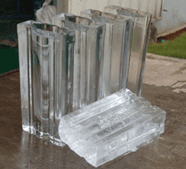 |
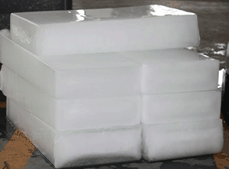 |
| Crystal Block Ice | Milky Block Ice |
Applications
Ice produced from the Tube Ice Plant and Cube Ice Maker is mostly used in the hospitality industry to mix or chill drinks. Flake ice from the Flake Ice Machine is commonly used to keep food fresh in your local shops and other applicable places. This also applies to the ice from Plate Ice Plants. Whereas ice from the Block Ice Machine can be left in its original shape and size or be crushed for any of the previously mentioned purposes.
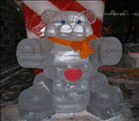
Industrial ice makers
Although the above mentioned are mostly industrial machines, some of the ice produced with these machines or systems can be consumed, however, the use of these machine are mostly for the production of large quantities of ice for industries such as fishery, fresh meat storage, construction, medicine, hospitality etc.
Apart from the Block Ice Plant, other industrial ice making machines may include the Tube Ice Machine, Flake Ice Maker, Cube Ice Machine and Flake Ice Plant.

Consumer block ice makers
For domestic and small scale ice production, the consumer block ice machines are ideal. These include Freezer Ice Makers, Portable Ice Makers, Built-in / Freestanding Ice Machines etc.
Refrigeration System Components
To fully appreciate the working principles of the refrigeration system, one has to also be familiar with the important components that are assembled together to make this phenomenon work. There are many parts to a refrigeration; the main components however, include the Compressor, Evaporator, Condenser, Expansion Valve and Refrigerant.
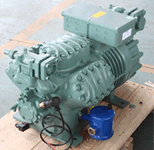
Compressor
The compressor’s main function in the refrigeration process is to draw the low-temperature, low-pressure vapour from the evaporator through the pressure line. Once drawn, the vapour is then compressed. Vapour rises in temperature when it is compressed. As a result, the compressor converts the vapour from a low-temperature vapour to a high-temperature vapour, subsequently increasing the pressure. From here, the vapour is then released from the compressor in to the discharge line.
Evaporator
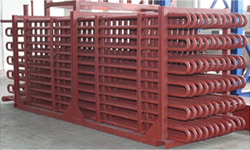
The evaporator’s main function is to remove excess heat from the product being chilled, through the liquid refrigerant. The liquid refrigerant contained within the evaporator usually boils at a low-pressure; however, the level of this pressure may be determined by factors such as:
- The rate at which the heat is absorbed from the product being chilled to the liquid refrigerant in the evaporator.
- The rate at which the low-pressure vapour is removed from the evaporator by the compressor.
To enable the transmission of heat, the temperature of the liquid refrigerant must be lower than the temperature of the product being cooled. Once transferred, the liquid refrigerant is drawn from the evaporator by the compressor via the suction line. When leaving the evaporator coil the liquid refrigerant is in vapour form.
Condenser
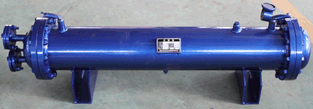
The condenser extracts heat from the refrigerant to the outside air. The condenser is usually installed on the outside of the ice making equipment, to enable heat to travel outside. Fans mounted above the condenser unit are used to draw air through the condenser coils. The temperature of the high-pressure vapour determines the temperature at which the condensation begins. As heat has to flow from the condenser to the air, the condensation temperature must be higher than that of the air.
The high-pressure vapour within the condenser is then cooled to the point where it becomes a liquid refrigerant once more, whilst retaining some heat. The liquid refrigerant then flows from the condenser in to the liquid line.
Expansion Valve
Within the refrigeration system, the expansion valve is located at the end of the liquid line, before the evaporator. The high-pressure liquid reaches the expansion valve, having come from the condenser. The valve then reduces the pressure of the refrigerant as it passes through the orifice, which is located inside the valve. On reducing the pressure, the temperature of the refrigerant also decreases to a level below the surrounding air. This low-pressure, low-temperature liquid is then pumped in to the evaporator.
Refrigerant
The type of refrigerant used will depend on the pressure capabilities of the system and the temperatures that have to be achieved during refrigeration. The following brief table shows the relationship between temperature and pressure, given in bar, for three common refrigerants.
| Temperature | Pressure in Bar (absolute) | |||
|---|---|---|---|---|
| ºF | ºC | R410A | R134a | R404A |
| -22 | -30 | 2.71 | 0.84 | 2.08 |
| -4 | -20 | 4.01 | 1.33 | 3.06 |
| 0 | 0 | 7.99 | 2.93 | 6.09 |
| 68 | 20 | 14.43 | 5.72 | 10.96 |
| 86 | 30 | 18.83 | 7.70 | 14.27 |
Manufacturers and Suppliers
Focusun Refrigeration (Shanghai) Corporation www.block-ice-machine.com
GEA Refrigeration Technologies www.gearefrigeration.com
U.S. Ice Machine Mfg. Co. www.usicemachine.com
Focusun Refrigeration (Shanghai) Corporation www.chinaicemachine.com
See also
Refrigeration
References
http://archive.org/stream/principlesandpr01schmgoog#page/n52/mode/2up
http://en.wikipedia.org/wiki/Icemaker
http://block-ice-plant.com/brine_system_block_ice_machine.html
http://home.howstuffworks.com/refrigerator4.htm
http://www.fao.org/wairdocs/tan/x5940e/x5940e01.htm
http://www.zitrec.com/Applications_indirect_cooling_systems.htm
http://en.wikipedia.org/wiki/Refrigeration
https://www.classle.net/book/refrigeration-and-refrigeration-cycles#
http://www.brighthubengineering.com/hvac/20353-methods-of-refrigeration-ice-refrigeration-and-dry-ice-refrigeration/
http://www.acerefrigeration.co.uk/refrigeration-design-installation/refrigeration-explained/
External links
http://www.chinaicemachine.com/about-us.html
http://www.kuelinda.de/
Contacts & Support
Focusun Refrigeration CorporationRoom 603, Baohong Center
No. 7755 Zhongchun Rd
Shanghai CHINA
ZipCode: 201100
Tel: +86-21-5108 9946
Fax: +86-21-5227 2259
Email: enquiry@focusun.com
Sales: sales@focusun.com
Marketing: marketing@focusun.com
Press: press@focusun.com
Newsletter: newsletter@focusun.com








